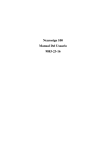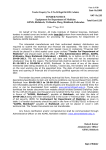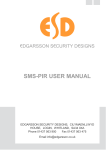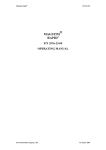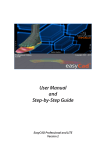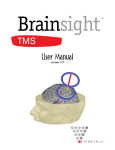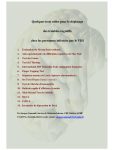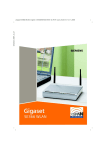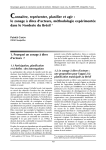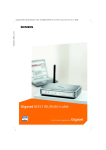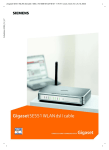Download Neurosign 100 Operating Manual 9883-23-P19
Transcript
Neurosign 100 Operating Manual 9883-23-P19 Neurosign 100 Table of Contents______________________________ Page Number Section 1: Guarantee 1 Section 2: Description 2 Section 3: Warnings and Precautions 3 Section 4: Front Panel Layout 5 Section 5: Rear Panel Layout 9 Section 6: Pre-Amplifier Pod 11 Section 7: Preparations for Use 12 Section 8: Sensing Electrodes - Electrode Placement Diagrams 13 14 Section 9: Stimulator Probe Pod 16 Section 10: Stimulation Probes 17 Neurosign 100 Page Number Section 11: Using the Neurosign 100 - Interpreting Audio Signals -Interpreting Neurosign Sounds - Suggested Stimulation Current Settings - Problem Solving Checklist 19 20 21 21 22 Section 12: Electrocautery Mute 23 Section 13: Maintenance and Servicing - Voltage Selection and Fuses - User Maintenance - Preventative Maintenance - Cleaning and Sterilising - Single-use Product Disposal - Servicing 24 24 24 25 25 25 26 Section 14: Accessories - Impedance Meter - Dual Pod Switch - Laryngeal Electrode - Needle Electrodes - Probes - Carrying Case - Equipment Trolley 27 27 27 28 29 30 33 33 Section 15: Specifications 34 Section 16: EMC 36 ©1999, The Magstim company Limited, Spring Gardens, Whitland, Carmarthemshire, Wales, U.K. All rights reserved. No part of this manual may be reproduced without the written permission of The Magstim Company Limited. Neurosign 100 SECTION 1: GUARANTEE_____________________________ Equipment manufactured by The Magstim Company Limited (“The Company”) is fully guaranteed covering materials and workmanship for a period of one year from the date of shipment, excepting those items detailed below. The Company reserves the right to perform guaranteed services in its factory, at an authorised repair station, or at the customer’s installation. Reusable Stimulating Probes are guaranteed covering materials and workmanship for a period of 3 months from the date of shipment. Reusable needle electrodes are guaranteed covering materials and workmanship for a period of 1 month from the date of shipment. Single use electrodes and stimulating probes are guaranteed to be free of defect upon use. Sterilisation is guaranteed subject to the packaging being undamaged and the product being within the serviceable life as stated by the sterilisation date shown on the label. The Company’s obligations under this guarantee are limited to the repair or replacement of any defective parts without charge if the defects occur during normal service. Claims for damages during shipment must be filed promptly with the transportation company. All correspondence concerning the equipment must specify both model name and/or number and serial number, as it appears on the invoice. Improper use, mishandling, tampering with, or operation of the equipment otherwise than in accordance with this Operating Manual will void this guarantee and release the Company from any further guarantee obligations. The Company will only accept responsibility for the safety, reliability and performance of the equipment if: • modifications or repairs are carried out by persons authorised by the Company, and • the electrical installation of the room in which the equipment is used complies with local regulations, and • the equipment is used in accordance with the operating instructions. No statement in this Guarantee limits the statutory rights of a purchaser of this equipment in the United Kingdom. The Magstim Company Ltd 9883-23-P19 Page 1 31st October 2005 Neurosign 100 SECTION 2: DESCRIPTION_______________________ The NEUROSIGN 100 Nerve Monitor has been designed to meet the needs of operating theatre staff by continuously monitoring motor neural pathways which are at risk during surgical procedures. The instrument gives an audible interpretation of muscle activity, which is sensed by needle electrodes placed into the relevant muscles controlled by those nerves to be monitored. Note: Muscle contractions are only possible if limited or no neuromuscular block is used. The Neurosign 100 cannot be used in instances where the patient is paralysed. The train of four stimulator should not be used as proof that any blockade has dissipated; the Neurosign 100 can detect EMG well below the threshold of visible muscle movement. Activity near the nerve at risk will cause associated motor units to contract and the instrument will emit a distinctive sound, the level of which is proportional to the stimulus applied to the nerve. The nerve may also be directly stimulated using a small current via a Stimulation Probe. There are a number of outputs available on the rear of the machine, to enable an EMG instrument, oscilloscope, chart recorder or computer to be connected. Dedicated software is available to enable an operation to be data-logged and the waveforms analysed. This instrument is supplied with a Bipolar Stimulation Probe, Pre-Amplifier Pod, Stimulator Probe Pod, Needle Electrodes, Mute Sensor and the main signal processing unit. For details on the availability of probe types and recording electrodes and their purchase, please see the Accessories Section 14 on page 25 and contact either The Magstim Company Limited (for the address please see Section 13), or your local distributor if outside the UK. All interconnecting cables used with the Neurosign 100, including mains cables and accessory connections, must be less than 3m in length. If this length is exceeded, EMC compliance may be compromised. The use of Accessories, transducers and cables other than those specified, with the exception of transducers and cables sold by the manufacturer of the equipment as replacement parts for internal components, may result in increased emissions, or decreased immunity of the equipment. The Neurosign 100 needs special precautions regarding EMC and needs to be installed and put into service according to the EMC information provided in Section 16 of this Operating Manual. In addition, portable and mobile RF communications equipment can also affect the Neurosign 100. The equipment should not be used adjacent to, or stacked with, other equipment and that if adjacent or stacked use is necessary, the equipment should be observed to verify normal operation in the configuration in which it will be used. The Magstim Company Ltd 9883-23-P19 Page 2 31st October 2005 Neurosign 100 SECTION 3: WARNINGS AND PRECAUTIONS______ ATTENTION!_____________________________________________________ The Neurosign 100 is designed for use during surgical procedures and must only be used by qualified personnel who have carefully studied this Operating Manual and read this section. This instrument is designed as an aid to surgeons in the identification and monitoring of motor nerves at risk during surgery. It is not a replacement for experience in surgical decision-making. Before use, ensure that the Voltage voltage selector is set correctly. Only use fuses of the correct type and rating (see Section 13). Serious damage may occur and a safety hazard exist if incorrect fuses are used, or the wrong voltage is selected. Do not twist the preamplifier cable around the pod when not in use, as this may fracture the internal cores of the cable. Coil the cable and use the retaining straps supplied with the pod Do not drop the instrument, the Stimulator Pod or the Pre-Amplifier Pod, or otherwise permit any physical damage to occur. Do not permit any liquid to be spilt such that it may enter the casing , via the ventilation slots on the side or through the bottom of the casing. Do not insert objects into holes or slots in the casing for cleaning purposes, as this may cause damage. Do not obstruct the ventilation slots. Use a lint-free cloth damped with alcohol to clean the instrument, the Stimulator Pod and the Pre-Amplifier Pod. Store the instrument in a dry atmosphere within the temperature range of 5°C - 30°C. The reusable Stimulation Probe(s) and the reusable Needle Electrodes (if specifically selected) obtained from The Magstim Company Limited, may be autoclaved (maximum temperature 140°C). Single use electrodes and stimulating probes are supplied sterile. If there are any signs of damage to the packaging, the electrodes, or probes, should be discarded. No attempt should be made to re-sterilise either used electrodes or probes, or electrodes or probes found to be in damaged packing. Needle electrodes should be removed from the patient by holding the heatshrink covering the end of the needle and pulling out the needle at the same angle as it was inserted. The needles should not be removed by pulling the connecting lead. This could cause damage and result in reduced performance or product life expectancy. The shaft of a single use concentric or monopolar probe may be bent once, to an angle not greater than 30º. Following bending, the probe function must be re-checked. Once bent, on no account should attempts be made to straighten the probe, as this will cause it to fail. Do not attempt to bend any other Neurosign Stimulating Probes, as they have not been designed to withstand bending, and will be damaged. High levels of RF, usually generated by electrocautery equipment, may interfere with the operation of the Mute Sensor if this device is not connected to the electrocautery cable. Do not connect the Mute Sensor to the Neurosign The Magstim Company Ltd 9883-23-P19 Page 3 31st October 2005 Neurosign 100 100 if the clamp is not to be attached to the electrocautery cable, or spurious muting of the Neurosign 100 may occur. Under extreme conditions, it may be possible that the mute sensor or the pre-amplifier may be affected by RF, in which case a few segments of the bargraph may light. In this case, the offending piece of equipment should be identified and replaced; alternatively, an improvement may be achieved by moving the pre-amplifier pod, stimulating pod, associated cables, or the position of the Mute Sensor. Any attempt to remove the securing screws will invalidate the guarantee. There are no user-serviceable parts inside. There are high voltages present and there is the danger of electric shock if the casing is opened. The use of this instrument other than as described in Section 11 may reduce the level of protection provided by the equipment. Contact The Magstim Company Limited prior to uses not described in the brochure. Before using the instrument, check that there are no signs of physical damage to either the main unit, the Pre-Amplifier Pod, the Stimulation Probe or the needle electrodes. The Stimulation Probe must be inspected after autoclaving for any signs of physical damage or deterioration and the tip(s) checked. They should be straight, parallel and rounded. Check the needle electrodes for physical damage. Replace as necessary. The use of needle electrodes when used near, or in conjunction with, electrosurgical equipment has the potential, under certain fault conditions of the electrosurgical equipment, to give rise to burns at the point of contact between the needle electrodes and tissue. It is therefore strongly recommended that the instructions for preparation and use relating to the electrosurgical equipment are strictly adhered to, and that the equipment itself is regularly checked for electrical safety and correct operation, particularly in relation to any automatic impedance measuring or current sensing safety devices. Only equipment which has an automatic cut-out feature and measures the return pad impedance should be used in conjunction with the Neurosign 100. The particular conditions which could give rise to such a potential risk are concerned with the electrosurgical unit’s return pad, often attached to the patient’s thigh. Thorough preparation of the area to ensure a reliable contact with low impedance is vital for patient safety. Because the risk is related to the return pad and its impedance with regard to the body, the risk is considered to lie exclusively with the use of monopolar electrosurgery. Bipolar electrosurgery, as its name suggests, uses its own active and return electrodes in the same forceps. It should therefore be considered whether monopolar electrosurgery is necessary when using nerve monitoring equipment. In order to reduce any possible induced current in the needle electrode leads from stray RF emitted by the electrosurgical unit, the electrode leads should be kept as far as possible from the unit. In practice, this means that the electrosurgical unit should not be positioned near the head of the patient. Cables from the electrosurgical unit, both active and return, should also be kept as far as possible from the electrode leads, especially whilst monopolar diathermy is being used. Consideration should therefore be given, prior to the surgery, to the balancing of the risks of the surgery to the nerve being monitored, and the possible risk of burns caused by any interaction between the electrosurgical machine and the Neurosign 100. The Magstim Company Ltd 9883-23-P19 Page 4 31st October 2005 Neurosign 100 SECTION 4: FRONT PANEL LAYOUT____________ FREQUENCY This switch has two positions, labelled 30Hz and 3Hz. It is recommended that no neuromuscular block is used other than for intubating the patient and that a suitable anaesthetic protocol is implemented so as not to impede muscle movement, in which case the frequency switch should be set to 30Hz. The advantages of this are that because of the higher frequency, the surgeon will need to stimulate the tissue for less time before correctly interpreting a positive response, and also that the CURRENT CONFIRM circuitry will be able to check that the correct current has passed more quickly. A neuromuscular block will reduce or eliminate the responses from mechanical distortion of the nerve, which is the normal early warning to the surgeon. If a neuromuscular block has to be used throughout the operation, this switch should be set to 3Hz. At this frequency, the stimulation will overcome the block (as long as it is not too deep), although it may take 1-2 seconds to confirm that the correct current has been passed. Please note that a high dosage of neuromuscular block must be avoided, unless the patient needs to be paralysed for clinical reasons, as this will significantly reduce the compound muscle action potential. PROBE The Stimulator Probe Pod cable should be connected to the socket marked PROBE, unless the stimulator probe is not required for the procedure, in which case it may be left unconnected. It is a push fit in the socket and clicks home. It is removed by pulling the plug from the socket; do not pull the cable, or damage may occur. Always remove by holding the connector body - do not remove using the cable or by twisting the connector sideways from the housing. The Magstim Company Ltd 9883-23-P19 Page 5 31st October 2005 Neurosign 100 STIMULATOR This control sets the current which flows through the Stimulation Probe CURRENT and so through the tissue touched by the Probe. It can be adjusted from 0.05mA (50µA) to 5mA and consists of a narrow negative going pulse of 200µs at a frequency of either 30Hz or 3Hz, depending on the FREQUENCY switch setting. Note that most of the travel of this control is at the lower levels of current, below 1mA; the higher levels are used for stimulating through tumour mass and bone. Currents in excess of 1mA should not be used directly on the exposed nerve in surgery involving the cranial nerves. Although the minimum current setting varies dependent on the specific surgical procedure, and on the individual patient’s physiology, the current may be set to 0.2mA as a basic control value, but the user should be prepared to alter this in the light of experience. There is a simple table suggesting suitable stimulation currents on page 22. Further information on current settings for specific surgical procedures is outlined in the Procedure Sheets which are available from the Company or Distributor. In order to enable the surgeon to know that the set stimulation current has been passed through the Probe, an indicator labelled CURRENT CONFIRM is provided. This indicator will light when the set current is passed; therefore it will only light when the Probe is in good contact with tissue. It provides positive proof to the surgeon that the correct current has been passed, and also that the Stimulation Probe is functioning. When the CURRENT CONFIRM indicator is lit, the Stimulation Current Record on the rear panel provides a voltage proportional to the current set on the front panel - this, in conjunction with the EMG Outputs, may be used for datalogging. (See Section 14 for details of the computer software available). STIMULATOR TESTING The CURRENT CONFIRM indicator also provides a warning if the Stimulation Probe is faulty. During the operation, if the indicator stays on permanently check that the tips of the Probe are dry, clean and are not touching, and that there is no liquid material bridging them which could create an electrical path for current to flow. If cleaning the tips does not cure the problem, unplug the Probe. If the indicator light turns off, the Probe is faulty. If the indicator does not light, the Probe may be checked by shorting the Probe tips together, either physically or by using a damp cloth. It may be difficult to obtain a result at the highest current setting, so it is best to check the functionality of the Probe at the lowest current setting (0.05mA). If the indicator lights, the Probe is working. Ensure that both electrodes come into contact with tissue, not just the side of one electrode. If the indicator does not light, unplug the Probe and try another; if this Probe works, the first is faulty, but if this still does not work, the fault is likely to be in the Stimulation Pod. Reasonable care of all items will ensure a long life, but the components should be treated appropriately during the sterilisation and storage phases of the equipment’s life. The Magstim Company Ltd 9883-23-P19 Page 6 31st October 2005 Neurosign 100 CHANNELS 1& 2 These switches control each channel. When the indicator is orange, the channel is OFF; when the indicator is green, the channel is ON. The bargraph for each channel will light showing the level of EMG activity. Each bargraph is calibrated from 30µV to 20mV peak-to-peak. In practice, with the electrodes correctly placed, no part of the bargraph should light unless the muscle is stimulated, either spontaneously or by the surgeon, either through manipulation or electrical stimulation of the nerve. When EMG is detected, the bargraphs rise; when the EMG ceases, the bargraphs fall. However, in order to allow the user to determine the level of the response, or to identify the channel, the top segment of the EMG response remains lit for a period of several seconds before decaying. When the unit is first switched on, the bargraphs light and a beep is heard. This allows the user to see that all the segments are working correctly. ELECTRODE The Neurosign 100 contains circuitry to detect the level of artifact present WARNING at the output. Experience has shown that where the electrodes are poorly placed, perhaps in fatty tissue rather than muscle, or the incorrect electrodes have been used, then a large amount of artifact may be present and can degrade the quality of the output available; this possibility can be avoided by using the Impedance Meter, described in Section 14. The Neurosign 100 detects this artifact, and sounds a warning in the following manner. For the purposes of this manual, artifact can be defined as unwanted voltages present in the body or in the electrical environment of the Operating Theatre. Each channel is monitored independently. Artifact must be present continuously for a period of 20 seconds, when the ELECTRODE WARNING light will illuminate and a short beep will repeat every 8 seconds until the problem is cleared. Should the artifact fall below a certain level, even for a moment, the warning circuitry will reset and the process will start again. There are three reasons why the ELECTRODE WARNING indicator may light; • continuous monopolar electrocautery is being used for a period greater than 20 seconds, injecting artifact into the patient. The ELECTRODE WARNING indicator will extinguish as soon as the electrocautery stops • the electrodes are poorly positioned or have become detached; the use of the Impedance Meter will prevent the former, whilst proper taping of the electrode leads as shown in the diagrams on pages 13 and 14 will reduce the risk of the latter • there is continuous EMG activity for more than 20 seconds; such continuous EMG activity is not usually a good sign, in that it represents continual irritation of the nerve. The Magstim Company Ltd 9883-23-P19 Page 7 31st October 2005 Neurosign 100 When the indicator sounds, the electrodes should be checked at the earliest convenient point in the surgical procedure, if possible. Experience has shown that correctly placed electrodes of the appropriate type will not give problems. Care should be taken during placement (see Section 8) and it should be remembered that strong muscle contractions could easily disturb the electrodes. The electrodes should be securely fixed to the patient as well as properly located and inserted. VOLUME This knob controls the volume of the sound available from the speaker, but does not affect the bargraph displays or the BNC outputs available at the rear of the machine. The instrument utilises a compression technique so that small signals are amplified more than large signals. This improves the sensitivity of the instrument at low signal inputs, whilst still giving powerful warning of very high input levels, occasioned by either direct stimulation or mechanical distortion of the nerve. The volume control cannot be set to zero; this is a safety feature in case the control is accidentally set to the minimum and the surgeon is not aware of the fact. CHANNEL In most circumstances, the surgeon will find it desirable to monitor two IDENT sets of muscles together. If it is important however, to be able to differentiate between the two nerve branches being monitored, the CHANNEL IDENT switch should be set ON. This introduces a different texture to the sound output for each channel. This difference is only applied to the speaker; the outputs available for connection to external devices do not include this Channel Identification colouration. The Magstim Company Ltd 9883-23-P19 Page 8 31st October 2005 Neurosign 100 SECTION 5: REAR PANEL LAYOUT_______________ MAINS The standard IEC power lead should be connected before the unit is CONNECTOR switched on. The unit is OFF when the switch is at the 0 position, and ON when at the 1 position. There are two fuses, rated at T630mA for 100-120V operation, or T315mA for 220-240V operation, next to the power lead connector. The fuses may be checked or replaced by removing the fuseholder cover. This cover also provides access to the voltage selector. Although it is unlikely that this will need to be changed, unless the instrument is shipped to another country, the mains voltage may be chosen by rotating the voltage selector and replacing the cover. A legend displays the voltage selected when the fuse cover is replaced. Do not select the wrong voltage, or replace fuses with those of a different rating, as severe damage may occur. EMG OUTPUTS These outputs come after 10kHz filters but before the signal conditioning necessary for the audio section, including the CHANNEL IDENT feature, and so may be directly connected to an EMG recording instrument or a computer and the waveforms captured and printed if required. The signal amplifiers have a gain of 500 and an output in the range 15mV to 10V peakto-peak. TRIGGER This TTL compatible output allows an oscilloscope, external chart recorder OUTPUT or monitor to be synchronised to the unit in order to obtain waveforms or hard copies. This facility may be used together with an EMG instrument. Using the Trigger Output and the appropriate hardware and software, the EMG Output can be captured by a computer. The Company distributes a dedicated package for this purpose (see Section 14). The Magstim Company Ltd 9883-23-P19 Page 9 31st October 2005 Neurosign 100 MUTE SENSOR A Mute Sensor can be used with the Neurosign 100 to cut out the sound output during electrocautery. The lead from the sensor should be attached to the Mute Sensor socket. The sensor itself should be clipped to the monopolar electrocautery cable near the diathermy machine. There is no adjustment available for the mute. If the mute is not required, do not connect the sensor and the Neurosign will operate normally, but do not attach the sensor and leave it lying unconnected to the electrocautery cable since it will detect spurious signals and may cause the Neurosign 100 to cut out randomly. Note that the bargraphs and EMG outputs are not affected by the mute, and they will show a high level of artifact during electrocautery. STIMULATION This output may be used to log the Stimulation Probe current setting with CURRENT respect to time, in conjunction with the Trigger and EMG Outputs. It RECORD provides a voltage proportional to the Stimulation Probe current set on the front panel; however, the actual current flowing through tissue is affected by the quality of the contact between the Probe and tissue. The voltage at the Stimulation Current Record Output is only present when the CURRENT CONFIRM indicator is lit; hence its value for data-logging. This output must not be confused with the Stimulation Probe; the Stimulation Current Record Output on the rear panel is not on the isolated side of the electronics, and must on no account be connected to the patient. HEADPHONES The Headphone connector will accept any 3.5mm stereo jack plug, and headphones with an impedance of between 20 and 100 ohms. Most lightweight headphones have an impedance of 32 ohms. The volume of the headphones is controlled by the thumbwheel knob on the rear panel; however, this control operates after the main volume control on the front panel, so both must be operated in order for the headphone output to function. The output from the headphones is in mono, even when both channels are used, so that information is not lost due to any hearing difficulties of individual surgeons. When using headphones, the mute will be found to be only partially effective, and some noise from electrocautery may be heard. No sound will be heard from the Neurosign 100 itself. PRE-AMP POD The cable from the Pre-Amplifier Pod is plugged into the PRE-AMP POD INPUT INPUT socket. The connector should be located in its socket and pushed firmly home. To unplug the cable, depress the tab and then remove the plug. Do not pull on the cable to remove the connector, as this may cause damage. OTHER The Neurosign 100 which accompanies this revision of the Operating Manual contains ciruitry to remove the stimulus artifact when using monopolar stimulation. The monitor essentially turns off for a period of 1.25ms after the stimulation pulse - long enough to remove the artifact, but short enough not to remove any response. The Magstim Company Ltd 9883-23-P19 Page 10 31st October 2005 Neurosign 100 SECTION 6: PRE-AMPLIFIER POD__________________ CARE AND The Pod may be cleaned using a lint-free cloth damped with alcohol. Do not MAINTENANCE use water, as this will cause the instrument to give poor results until completely dry, and may even cause damage. PREPARATION The Neurosign 100 detects very small voltages within a number of motor FOR USE units. In order to ensure that as little electrical noise as possible is amplified, the instrument utilises a Pre-Amplifier Pod, which should be placed on or near the patient, usually near the head either at the top rail of the operating table or at the side. The Pod is fitted with a clip to enable it to be attached to the rails on the table; alternatively, it may be laid on the patient’s chest or secured elsewhere as required. The cable from the Pod should be connected to the Pre-Amp Pod Input socket on the Rear Panel of the instrument. Three electrodes are used to monitor each muscle group. The use of disposable needle electrodes is recommended in terms of performance, and staff and patient safety. Two of these electrodes are connected to the differential amplifier inputs, +ve and -ve (colour coded red and black), and the third is connected to the reference input, Ref (colour coded green). Care should be taken to connect the electrode wires correctly. The best results will be obtained if the wires from each muscle group are lightly twisted together - this reduces the amount of noise the wires pick up before they reach the Pre-Amplifier Pod. The use of the correct electrodes is absolutely essential, and it is recommended that only electrodes obtained from the Magstim Company Limited are used. The Company cannot guarantee the instrument’s performance if these electrodes are not used. They may be taped either to the bed or the patient as required. For further information see Section 8. . The Magstim Company Ltd 9883-23-P19 Page 11 31st October 2005 Neurosign 100 SECTION 7: PREPARATIONS FOR USE____________ The instrument should be prepared for use as follows: . • clean the instrument with a dry cloth or a lint free material damped with alcohol. • place the Stimulation Probe (and reusable electrodes if these are being used) in an autoclave for the prescribed period (see Section 13). Single use needle electrodes and stimulating probes are supplied sterile. • insert the electrodes and connect them to the Pre-Amplifier Pod (see Section 8 on Electrode Placement and Section 6 on the Pre-Amplifier Pod for connections). • ensure that CHANNEL 1 and CHANNEL 2 switches are both OFF. • attach the Pre-Amplifier Pod to the patient or bed and plug the cable into the PRE-AMP POD INPUT Socket on the Rear Panel of the NEUROSIGN 100. • connect the power lead to the power input module socket with the power switch at 0. • set power switch to 1; the orange LEDs will light. • turn on CHANNEL 1 and CHANNEL 2 as required. • with the electrodes connected and correctly inserted, there should be no segments lit on the bargraph with the patient at rest. For the first few minutes after needle insertion, and whilst the patient is being draped, it is normal for a few segments to flicker - the muscle is irritated by the electrodes! If segments are continuously lit, check the location of the electrodes and the wiring to the Pre-Amplifier Pod; if all the wiring appears to be in order, remove and resite the electrodes (see Section 8). • it is strongly recommended that the Impedance Meter available from the Company is used to check electrode placement before the patient is finally draped. This device ensures that electrodes are placed in muscle tissue and also highlights any problems there may be with the electrodes themselves. • raise the front of the Neurosign 100 by altering the handle position in order to allow low level sounds to be heard. • plug the Stimulator Probe Pod into the front panel connector, and locate conveniently near to the patient. This is often at the foot of the table, where the Pod can remain in the non-sterile area for easy attachment of probes. • connect the Stimulation Probe to the Stimulator Probe Pod, observing the colour coding. The Magstim Company Ltd 9883-23-P19 Page 12 31st October 2005 Neurosign 100 SECTION 8: SENSING ELECTRODES____________ TYPES OF Dependent on the procedure being monitored, and individual preferences, ELECTRODE different electrodes may be used. Surface electrodes may be suitable in some instances, although in the majority of cases intra-muscular, noninsulated, stainless steel needle electrodes have been found the most satisfactory. An electrode to monitor the vocal cords is also available (see Section 14). ELECTRODE The exact muscle location for the electrodes will vary according to the PLACEMENT surgical procedure being performed. It is important that the active electrodes are inserted within the muscle proper, and are not merely resting in fatty tissue. This could occur if an electrode were to be poorly placed or even passed through the muscle, reaching fatty tissue on the far side. The reference electrode should be placed close to the muscle itself to reduce artifact pick-up, but not in the same muscle group. For monitoring the facial nerve during the resection of acoustic neuromas, mastoid surgery or ear surgery, it is suggested that two muscle groups are monitored, one above the eye and the other in the lip. For the lip, the reference electrode (coloured green) should be inserted into the orbicularis oris above the vermillion border of the upper lip, with the sensing electrodes (coloured red and black) inserted into the orbicularis oris below the vermillion border of the lower lip. When placing the electrodes around the eye, the sensing electrodes should be inserted in the frontalis, with the reference electrode inserted in the upper cheek near the nose in the levator labii superioris. It is important to keep the electrodes away from the masseter surgery of the cerebello-pontine angle otherwise extraneous Vth nerve activity may be detected and misinterpreted. For parotid surgery, the electrodes must be spread to include the four major branches of the facial nerve. See the diagrams on pages 14 and 15. The electrodes must not touch each other, or a noisy or nil output will be obtained. They should be inserted parallel to each other, to reduce the risk of internal contact, and approximately 5-10mm apart. It will help to reduce noise and interference from other equipment if the wires are lightly twisted together, as supplied. The electrodes should be firmly attached to the patient using adhesive tape. Movement of the patient’s head or strong contractions can dislodge the electrodes and so the insertion of a “slack loop” in the electrode wires en route to the Pre-Amplifier Pod is a wise precaution. Refer to the diagrams on page 13 and 14 for the suggested placement of electrodes. In procedures where it might be useful to be able to monitor several muscles over a long period of time, the Neurosign 100 Dual-Pod Switch may be used. This allows two Pods to be connected, and the user may switch between the two Pods. This enables four muscles to be monitored (see Section 14). The Magstim Company Ltd 9883-23-P19 Page 13 31st October 2005 Neurosign 100 ELECTRODE PLACEMENT DIAGRAMS Fig. 1: Electrode placement for acoustic neuroma, mastoid and ear surgery Fig. 2: Electrode placement suitable for Parotid gland surgery Fig. 3: Electrode placement suitable for 4 Channel monitoring of the facial nerve (requires Dual Pod Switch) The Magstim Company Ltd 9883-23-P19 Page 14 31st October 2005 Neurosign 100 Fig. 4: Electrode placement suitable for submandibular gland surgery Frontalis Orbicularis ocili Levator labii superioris Orbicularis oris Mylohyoid Fig. 5: Brachial Plexus muscle sites Nerve Radial Ulnar Median Posterior interosseous Axillary Musculocutaneous Suprascapula Medial pectoral Muscle Brachioradialis, triceps brachii, anconeus, extensor carpi radialis longus Flexor carpi ulnaris Pronator teres, pronator quadratus, flexor carpi radialis, palmaris longus, flexor digitorum superficialis Supinator, extensor carpi ulnaris, extensor digitorum, extensor indicis, extensor pollicis longus Deltoid, teres minor Coracobrachialis, biceps brachii Supraspinatus, infraspinatus Pectoralis major, pectoralis minor Fig. 6: Flexible electrode for use in thyroid surgery Electrode tail Sensing tracks of electrode Active area of electrode Black lines on tube Cuff The Magstim Company Ltd 9883-23-P19 Page 15 31st October 2005 Neurosign 100 SECTION 9: STIMULATOR PROBE POD_________ CARE AND The Pod may be cleaned using an MAINTENANCE alcohol damped, lint-free cloth. Do not use water. The cable and connector may be washed in water as required. Dry off the parts with a cloth and allow to dry completely before storage. The Pod may be ETO sterilised if necessary. Do not autoclave. Sterilisation of the Pod by any other means will invalidate the guarantee. RATIONALE To enable disposable Probes to be connected, a Stimulator Probe Pod is supplied. The cable from the Stimulator Probe Pod should be taken back to the Neurosign 100 and plugged into the PROBE connector. The connector is a push fit onto the socket; it is in position when a click is felt. When removing the plug, do not pull on the cable, as this may cause damage. Always pull on the connector body. The Pod should be placed in an accessible position, or it may be placed out of reach if the Probe(s) is connected before the patient is draped. Where possible, place the Pod at the opposite end of the table to the surgery usually the feet. This enables the Pod to be kept in the non-sterile area, where Probes can easily be attached or disconnected. When connecting Probes, ensure that the colour coding is observed - this is especially important for monopolar probes, which will not function if wrongly connected. It is important to realise that if two Probes are connected, both Probes will be “live”. In practice, there is little risk of a Probe accidentally stimulating the patient, but if the CURRENT CONFIRM indicator is lit even when the surgeon is not stimulating tissue, then both Probes should be checked to remove the problem. Probes must not be left standing in saline, or allowed to contact other electrical devices. PROBE The probe, pod and stimulator can be checked by placing a damp cloth TESTING across the electrode tips with the current set to 0.05mA. The CURRENT CONFIRM indicator should light. If it does not, there is a fault. The Magstim Company Ltd 9883-23-P19 Page 16 31st October 2005 Neurosign 100 SECTION 10: STIMULATION PROBES________ REUSABLE Both single use and reusable Stimulating Probes are available for use with PROBES the Neurosign. These are as follows: Disposable Reusable - concentric probe, bipolar probe and monopolar probe bipolar probe, concentric probe and monopolar probe Surgeons may choose their probe type according to individual preferences and the demands of each procedure. These are further described in Section 14. The use of the Probes varies slightly according to their type; all reusable probes may be autoclaved. The bipolar Probe should be plugged into the connectors on the Stimulator Probe Pod when required, observing the colour code. BOTH Probe tips must come into contact with tissue in order to pass current. If the area to be stimulated is very wet, for example after being irrigated with saline solution, much of the current from the Probe could flow through this liquid rather than through tissue. The area to be stimulated should be made as dry as reasonably possible before stimulation. Should the CURRENT CONFIRM indicator stay lit after stimulation, this implies that there is still an electrical connection being made between the Probe tips, probably by liquid picked up during the procedure. This should be cleaned off before the Probe is used to stimulate tissue again. The concentric Probes are very precise and have a diameter of only 1mm. They are especially useful when working with the microscope, and allow the surgeon to differentiate between the VIIth and VIIIth cranial nerves, to stimulate within the Internal Auditory Canal, or to stimulate fine fibres of the extra-cranial nerve without stimulating surrounding tissue. See Section 14 for further information. The earth lead of the monopolar Probe should be connected to the patient via a sub-dermal, uninsulated reference electrode inserted at the operating site when required. Alternatively, the reference needle may be placed in the shoulder before the patient is draped. This needle electrode should then be connected to the white socket on the Stimulator Pod, and the monopolar probe wire attached to the blue socket. The probe shaft is insulated to the end, so it is capable of very precise stimulation, although it is difficult to control the degree of current spread. The Probe should be touched onto the tissue until the nerve is located, observing the same rules as to dryness as above. A higher current setting may be required using a monopolar Probe do not exceed 1mA, as the higher current settings up to 5mA are for stimulating through bone only. The monopolar probe is designed to be used to stimulate the tumour mass, or where a large current spread is required. It is not intended to be as accurate as the bipolar series of probes, nor should it be used to try and stimulate through bone. The Magstim Company Ltd 9883-23-P19 Page 17 31st October 2005 Neurosign 100 Some Probes have their tip(s) covered with a PTFE coating. This insulates the tips, other than the working surfaces, to prevent current being shunted between the tips by liquid or tissue. This coating is fragile, and care should be exercised so as to avoid scratching it, especially during the autoclaving process. It is recommended that Probes are placed in two part bags before being put in the autoclave. See page 21 for a table of suggested stimulation current settings, together with maximum suitable values, for a number of usual stimulation tasks. DISPOSABLE The instructions for the surgeon, when using a disposable probe, are the PROBES same as for reusable probes. Disposable probes are for single use only, and no attempt should be made to resterilise them. Disposable probes are designed to allow the surgeon to bend the shaft of the probe up to a maximum of 30°. This allows the surgeon to use the probe under a microscope. Only one bend is permitted. Do not straighten or over-bend the probe, or it may fail. DISPOSAL Dispose of the single-use probe immediately after surgery using a “sharps” safety box. The Magstim Company Ltd 9883-23-P19 Page 18 31st October 2005 Neurosign 100 SECTION 11: USING THE NEUROSIGN 100________ Before use, refer to Section 3 for Warnings and Precautions, to Section 7 for Preparations for Use, Section 8 for Electrode Placement and Section 13 for Cleaning and Sterilising. With all leads connected and the power switch set to 1, the instrument should be checked as follows: Set CHANNEL 1 switch to ON; the Orange indicator will change to Green. If the electrodes are correctly placed, no section of the bargraph should light. Set the Volume Control to the desired level – probably about half way through its travel. If CHANNEL 2 is to be used as well, set switch to ON position and check that no section of the bargraph is alight. If any segments are permanently lit, check the Electrode Placement (see Section 8). If required the CHANNEL IDENT switch may be set to ON, so that there will be a noticeable differentiation between the two channels. The CHANNEL IDENT may be turned off at any time by setting the switch to the OFF position. If only one Channel is being used, the CHANNEL IDENT should be set to OFF. The FREQUENCY switch should be set to 30Hz, except where the patient is to be paralysed for the whole procedure. In these cases the FREQUENCY switch should be set to 3Hz, and the surgeon should be made aware that responses due to electrical stimulation will sound slow and may be weak in comparison to situations where the patient is not paralysed. The surgeon must also be made aware of the fact that, should the patient be paralysed, there will be no mechanically elicited responses. There should be no sound or display from the instrument until the procedure reaches the point where a neural pathway can be stimulated, other than that caused by spontaneous firing of the nerve. At this point the integrity of the system can be confirmed by use of the Stimulation Probe. The Stimulator Current should be set to the minimum level appropriate for the procedure and the area checked for nerve fibres. Should there be no reaction, or only a weak reaction, the Stimulator Current may be increased. The control is calibrated in a logarithmic manner, so most of the rotation of the control is between 0.05mA and 1mA, with only a small rotation required to take the current to 5mA. A strong reaction is normally available at a current of 0.2mA, so care should be exercised and the procedure should start with the current at its lowest setting. The current setting should always be at the lowest level which produces a satisfactory result. As a guideline, where the nerve is unmyelinated, a brisk response should be available at a setting of 50µA, and where the nerve is myelinated, the setting is likely to be 0.2mA. Nerves other than the VIIth may react in different ways – for example, the recurrent laryngeal nerve often requires 0.5mA to 1mA. The Magstim Company Ltd 9883-23-P19 Page 19 31st October 2005 Neurosign 100 When the Stimulation Probe comes into contact with a neural pathway, the associated muscle will contract and the instrument will register a response dependent upon the level of stimulation; the contraction may be below the threshold of visible movement. The sound level is governed by the Volume control, but the bargraph display will show the actual level of activity irrespective of the setting of the Volume control. The bargraph has a peak hold facility which keeps the top bar at the maximum signal level for a period of 7 seconds after the response. This allows the user to examine the machine once a response is heard to determine which channel was stimulated. The volume level is a matter of personal choice, but there is useful information even during quiet periods, in that as the surgeon works closer to neural fibres, so small reactions are picked up and provide a degree of early warning. Should the instrument begin to ‘beep’ at any stage of the procedure, the front panel will display an ELECTRODE WARNING light. This means that there may be a problem with the electrodes for that particular channel, which should be checked when convenient. Provided that the problem is not severe, i.e. the whole bargraph is not lit, the instrument may continue to operate with reduced efficiency. Refer to Section 8 for details of Electrode Placement. If a click is heard each time a surgical instrument touches tissue, this is likely to be caused by either metal to metal contact or by a build up of static charge on the surgeon or instrument. This charge can be caused by the use of dissimilar metals in the instruments or by poor grounding and anti-static precautions in the Operating Theatre. In any event, these artifacts will be minimised by good electrode placement. Using swabs to insulate instruments from retractors will also help to reduce these artifacts. INTERPRETING There are four basic sounds from the instrument when used correctly. The AUDIO SIGNALS first is due to direct electrical stimulation, and forms a series of pulses which last as long as the nerve is stimulated. The volume of the signal will vary according to the current being passed, the amount of neuromuscular block (if any) used, and the integrity of the nerve. The second is caused by direct manipulation of the nerve. A brief mechanical contact, caused by the surgeon working close to the nerve, will be interpreted as a burst of clicks, ending as the contact is removed. The third is formed by a regular, repetitive ‘train’ of clicks lasting several seconds or even minutes. This ‘train’ of pulses may be caused by mechanical manipulation of the nerve, i.e. compressing or stretching it, or by a change in temperature, as when irrigating the area with saline or heating the area by diathermy or with a laser. Unless the train of pulses is caused by irrigation, it may be advisable to allow the nerve to recover before continuing with the procedure. The fourth is an absence of sound! Because the instrument registers the voltage in the muscle, it follows that the muscle must contract in order for a sound to be heard. The muscle may not contract for a variety of reasons; the nerve may not be stimulated; the nerve may be damaged or transected; or any neuromuscular block may be too deep. The Magstim Company Ltd 9883-23-P19 Page 20 31st October 2005 Neurosign 100 INTERPRETING NEUROSIGN 100 SOUNDS CAUSES DESCRIPTION TYPICAL SOUND Regular clicks at the Stimulator frequency when using the Stimulator Probe; a weak sound may indicate that the nerve lies behind the stimulated tissue. Pulses Electrical Stimulation Burst Direct Surgical Manipulation Train Silence - Stretching of the nerve Compression of the nerve Irrigation Heating (ie. laser or diathermy) - Nerve not present - Nerve not stimulated - Incorrect stimulation technique - Patient paralysed - Nerve damaged prior to surgery - Electrodes in wrong muscle group Clicks synchronised with surgical manipulation of the nerve or tissue to which the nerve is attached; often sounds like the rustling of tissue paper. Continuous clicks lasting several seconds or even minutes after the end of some surgical action. Except for irrigation, which is caused by the temperature difference between the saline and tissue and is believed to be harmless, a train response is a warning that the nerve has been irritated significantly and the surgeon should wait until the response dies down. This type of response is important and should not be ignored . Silence can often be worrying until the first positive response is obtained. Frequently surgeons expect to hear responses long before they are close to the nerve. Normal anatomic procedures for locating the nerve should be followed - the monitor will detect the nerve when the surgeon comes close. Silence is also a sign that the surgery is not irritating the nerve, and as such is the ideal state of affairs. Maximum setting SUGGESTED STIMULATION CURRENT SETTINGS (all values have a tolerance of ±20% or 25µA, whichever is greater) Between IAC and brainstem (unmyelinated) 50µA (minimum setting) 0.5mA Myelinated facial nerve 0.2mA - 0.5mA 1mA Recurrent laryngeal nerve 0.5mA - 1.5mA 3mA Bone at the IAC 0.2mA - 0.5mA 3mA Bone in middle ear surgery 0.5mA - 1mA 3mA Bone in mastoid surgery 0.5mA - 5mA 5mA Spinal motor root 0.5mA - 1mA 2mA Stimulating tumour capsule to check for nerve fibres 1mA - 3mA 5mA The Magstim Company Ltd 9883-23-P19 Page 21 31st October 2005 Neurosign 100 PROBLEM SOLVING PROBLEM CURE No indicators light when power is switched on Check Power Switch is set to 1: check power socket; check voltage selector; check unit fuses Background theatre noise obscures Neurosign 100 information Increase volume or use headphones Loud noise when using electrocautery Attach the mute sensor and clip it to the electrocautery cable – bipolar diathermy should not affect the Neurosign 100, but this can also be muted if necessary No response at start of operation This is normal! It may take a long time to reach the nerve or tissue to which the nerve is attached; if in doubt, use the stimulator set at a high current (2-3mA) to check the area – a faint clicking may be heard indicating the nerve lies deep to the probe If any neuromuscular block has been used, anything other than direct electrical stimulation is unlikely to be heard – the train of four test is not a guarantee that the neuromuscular junction is free of blockade Little or no mechanically evoked responses Part of the bargraph has been lit for more than 20 seconds. The electrodes may be poorly placed or faulty, giving rise to artifact. Check if possible, and use the Impedance Meter before the patient is draped Constant clicking noise and bargraph display with no stimulation; ELECTRODE WARNING indicator on and beep sounding a) If a neuromuscular block has been used, set FREQUENCY switch to 3Hz b) If neuromuscular block is deep, a response is unlikely c) Is the CURRENT CONFIRM indicator lighting? d) Increase current setting up to a maximum of 1mA e) Did the patient have a normal nerve preoperatively? (!!) No response when using Stimulator CURRENT CONFIRM indicator stays lit after Stimulation is finished Check for liquid material between probe tips and clean as necessary. Concentric probes may cause the indicator to stay lit for several seconds because of the proximity of the electrodes The concentric probes have a diameter of 1mm and also have very much reduced current spread, making these probes suitable for use under the microscope and, for example, differentiating between VIIth and VIIIth cranial nerves Bipolar probe is too big under the microscope and penetrates too far through tissue Difficulty in differentiating between the two channels Data-logging is required The Magstim Company Ltd 9883-23-P19 Set INDENT feature to ON, and ensure that the muscle group for each channel is noted Use EMG Channels, Trigger and Stimulation Current Record to log activity as required using as oscilloscope or chart recorder, or use Neuroscreen software package for analysis Page 22 31st October 2005 Neurosign 100 SECTION 12: ELECTROCAUTERY MUTE________ The Neurosign 100 is fitted with a sensor to enable the sound artifact from monopolar electrocautery to be muted. It is not usually necessary to mute bipolar diathermy since the electronics of the pre-amplifier pod can reject a high level of common input signals, but occasionally a noisy diathermy machine or a poor operating theatre electrical environment may make this desirable. SETTING UP Clip the blue Mute Sensor around the monopolar lead and connect the BNC plug to the socket marked “Mute Sensor” on the rear panel. There is no further setting up to be done. The easiest place to clip the sensor is usually near the electrocautery machine. If the sensor cable is not long enough, it may be extended using a BNC to BNC adaptor cable, though such an extension should be avoided if possible, and a suitable location allowing connection of all peripheral items without cables interfering with theatre staff movement is usually easily arrived at. The mute will also cut out bipolar diathermy, if required, by clipping the sensor around the bipolar cable. Both monopolar and bipolar leads can be clipped in together if both are to be muted. Please note, however, that the Neurosign 100 will not normally be affected by bipolar diathermy, and useful information about inadvertent stimulation due to proximity, movement or thermal effects may be lost. DESCRIPTION The mute is designed to cut out the speaker when monopolar electrocautery is used. The bargraphs will show a high level of interference, as will the EMG Outputs from the rear panel. This is to be expected - valid monitoring will not take place during monopolar electrocautery, although bipolar diathermy will leave the unit unaffected. Should the mute not be required during the operation, disconnect the BNC from the rear panel. Do not simply unclip the sensor and leave it connected to the Neurosign 100, as it may detect spurious signals and cut out the speaker unintentionally. The Magstim Company Ltd 9883-23-P19 Page 23 31st October 2005 Neurosign 100 SECTION 13: MAINTENANCE AND SERVICING____ VOLTAGE The Neurosign 100 is preset at the factory to operate at 100V, 120V, SELECTION AND 230V or 240V A.C., as appropriate. The following are the fuse ratings: FUSE RATING SUPPLY FUSE(S) VOLTAGE Qty Size Rating 100-120V~ 220-240V~ 2 2 20 x 5mm 20 x 5mm T630mA 250V T315mA 250V The fuses may be changed by opening the fuse cover, pulling out the fuse trays (marked with an arrow), replacing the blown fuse with one of the correct rating, and by locating and pushing home the trays. Replace the fuse cover. The voltage may be selected by removing the fuse cover, rotating the selector and replacing the cover. A legend will indicate the voltage selected when the fuse cover is replaced. Do not replace fuses with those of the incorrect rating, or operate the instrument with the voltage selector set at an inappropriate voltage. Serious damage may be caused. USER At the start of each session the Operator must check the Reusable MAINTENANCE Stimulation Probe for any signs of damage. It is important to:a) check that the spacing between the two wire tips is 2-3mm (bipolar Probe only); b) ensure that the end of the wire tip(s) remain rounded and c) that the cable and probe are in good mechanical condition with no splits, tears, cracks or loose connections. If there are any sharp protrusions on the Probe tips the Stimulation Probe must not be used. The needle electrodes must also be checked to confirm that they are in good condition. Poor quality electrodes will give poor quality results. Reusable needle electrodes should be used no more than 10 times before replacing, unless they appear in good condition and have been inspected under a 20X microscope for oxidisation and tissue deposits. On no account should single use electrodes or stimulating probes be reused. The Magstim Company Ltd 9883-23-P19 Page 24 31st October 2005 Neurosign 100 PREVENTATIVE MAINTENANCE Preventative maintenance is limited to visual inspection of the casing of the instrument, Pre-amplifier Pod, Stimulator Probe Pod and associated leads and probes, to check for any cracks or damage. Such inspection must be carried out before each procedure, and the instrument must not be used if there are any physical signs of damage. No further preventative maintenance is necessary. CLEANING AND The Reusable Stimulation Probes and Reusable electrodes may be STERILISING sterilised by gas sterilisation, chemical sterilisation or autoclaving, but the maximum temperature rating of 140°C should not be exceeded. Reusable probes and electrodes should be cleaned after use following the hospital’s policies and procedures. • initially, items should be washed under hot running water to remove blood and tissue contamination; • items may be further cleaned using disinfectant and a lint-free cloth. • do not use an abrasive cleaner since this will damage the PTFE coating on some probes (identified as a black coating near the probe tip). • do not use excessive force when cleaning the probes. The probes are fragile and should be cleaned with care; cables should be washed but not pulled. • there are no lumens in either the reusable probes or electrodes. • reusable probes and electrodes may be washed by machine so long as the maximum working temperature of 140°C is not exceeded. Items should be placed in a plastic or non-metallic container if they are to be machine washed. Do not place items on top of probes or electrodes. • the exterior of the main unit, the Pre-Amplifier Pod and the Stimulator Probe Pod may be cleaned using an isopropyl alcohol BP 70% alcohol moistened, lint-free cloth. SINGLE USE Disposable items should be discarded after use following the hospital’s PRODUCT procedures for disposal of contaminated sharps. On no account should DISPOSAL they be sterilised and reused, as they have not been designed for this purpose, and both the item’s and the instrument’s performance, safety and efficacy will be impaired. The Magstim Company Ltd 9883-23-P19 Page 25 31st October 2005 Neurosign 100 SERVICING For further information or service contact The Magstim Company Ltd: The Magstim Company Limited Spring Gardens Whitland Carmarthenshire SA34 0HR United Kingdom. Telephone - General Enquiries: U.K: International: 01994 240798 +44 1994 240798 Telephone-SalesLine: U.K: International: 01994 241111 +44 1994 241111 Fax: U.K: International: 01994 240061 +44 1994 240061 email: Web Site: [email protected] www.magstim.com A service manual will be supplied to a qualified service repair station only after they have completed a service seminar sponsored by the Company. Unauthorised removal of securing screws, or any modification to the unit, including the use of any unauthorised accessories, will void the guarantee. The Magstim Company Ltd 9883-23-P19 Page 26 31st October 2005 Neurosign 100 SECTION 14: ACCESSORIES_____________________ The Neurosign 100 has a number of accessories which meet surgeons’ preferences or enable particular procedures to be carried out. These accessories are listed below, together with information for ordering items which have a limited life. Please note that all electrodes and probes may be autoclaved with the exception of the laryngeal electrode, single use needle electrodes and the disposable monopolar probe. Impedance Meter P/N 9913-00 The Impedance Meter has been designed to ensure that electrodes are correctly placed in muscle tissue and not in fat. The device measures the impedance between the electrodes and displays this on a bargraph with a simplified scale, which does not require expert knowledge to interpret. It is battery powered and may therefore be used before the patient is draped, and whilst electrodes can still be repositioned if necessary. It is completely self-sufficient, and does not need the Neurosign 100 to be connected. It may be used to measure the impedance of intramuscular needles or surface electrodes, and may therefore find applications in other departments. Dual Pod Switch P/N 1037-00 The Magstim Company Ltd 9883-23-P19 This device enables two Pre-Amplifier Pods to be connected at the same time, thus providing four channels for monitoring. The Dual Pod Switch activates either Pre-Amplifier Pod individually, with the unused Pod electrically disconnected; or it combines the output of each Pre-Amplifier Pod into a single channel. Hence Pod A output appears on channel 1 of the main unit and the output of Pod B on Channel 2. This enables the monitoring of the VIIth, IXth, Xth and XIIth nerves, for example, during acoustic neuroma surgery. Other applications may arise in complex parotid, spinal or brachial plexus surgery. Page 27 31st October 2005 Neurosign 100 Pre-Amplifier Pod P/N 1719-00 (formerly 9921-00) A second Pre-Amplifier Pod is required if the Dual Pod Switch is to be used. It is identical to that supplied with the Neurosign 100. ELECTRODES Laryngeal Electrode1 P/N 1011 - 00 to fit 8 or 9mm intubation tubes, qty. 10 P/N 1035 - 00 to fit 6 or 7mm intubation tubes, qty. 10 Cable Assembly P/N 1180-00 This electrode has been specially developed to enable the recurrent laryngeal nerve to be monitored during thyroid surgery. It attaches to the endotracheal tube and is surgically non-invasive. However, it is also useful during acoustic neuroma surgery for monitoring the Xth cranial nerve. In such cases it will need to be used in conjunction with the Dual Pod Switch. The electrode will also detect stimulation of the superior laryngeal nerves during radical neck dissections. The careful use of anaesthetics which Electrode tail do not involve muscle relaxants is especially important when using this electrode during thyroid surgery as the Conductive Tracks surgeon will be close to the recurrent laryngeal nerve very quickly. Because Adhesive backed area the nerve will be at risk very soon after the start of surgery, insufficient time may have elapsed for any paralysing agents used during Black intubation to have worn off, and either lines allowance must be made for this by Cuff the surgeon, or the intubation procedure should be changed if possible and if appropriate for the patient. If it is necessary to paralyse the patient during the surgery, the electrode will still detect direct electrical stimulation of the nerve, but no mechanical responses will be elicited. The laryngeal electrode consists of an electrode and a cable assembly. The electrode is available in two sizes to suit different sexes and age groups. The electrode is supplied in boxes of 10, non-sterile, but each may be sterilised/disinfected by ETO or by immersion in CIDEX, ASEP or chlorohexadine for 10 to 15 minutes and followed by washing with copious amounts of sterile water. The cable assembly may be washed and sterilised using either a chemical sterilant or by ETO if this is considered necessary, but it will normally be outside the sterile field. The cable assembly is available separately and connects the electrode to the pre-amplifier pod. It will have a long life if treated with care. 1 Not available in the USA and some other countries The Magstim Company Ltd 9883-23-P19 Page 28 31st October 2005 Neurosign 100 Usage The electrode is sterilised using an appropriate technique. The backing paper from the adhesive area of the electrode is peeled off and the electrode pressed firmly onto the endotracheal tube as shown in the diagram on page 26; the patient can then be intubated as normal. Where possible, a laryngoscope should be used to visualise the vocal cords and confirm that the active area of the electrode is lying between them. It is strongly recommended that the Impedance Meter is used with this electrode, since it is often difficult to confirm its correct position by sight alone. The Meter ensures that the electrode touches the cords. The cable assembly is connected to the electrode, the electrode impedance is checked using the Impedance Meter, and the cable is then connected to the pre-amplifier pod. The left cord will appear on Channel 1, the right cord on Channel 2. If only one side of the larynx is being monitored, then only one half of the electrode need be connected; however, unless the remaining channel is to be used for another site, it is recommended that both sides of the electrode be connected. The electrode will detect the responses from electrical stimulation, and given a suitable anaesthetic protocol, the responses from mechanical distortion of the nerve. Single use Needle Electrodes - all stainless steel, Ø 0.4mm 20mm, sterile, qty. 20 Return electrode, 20mm, sterile, qty. 20 (for monopolar probe) P/N 1697-00 P/N 1705-00 Single use electrodes must be discarded after use. Do not attempt to reuse. Electrodes may be checked for correct location using the Impedance Meter. Reusable Needle Electrodes, non-sterile - all stainless steel, Ø 0.4mm CH1 and CH2, 20mm, qty. 1 set Return electrode, 20mm, qty. 10 P/N 1178-00 P/N 9957-00 The reusable needle electrodes are designed to have a long life, but they will need to be replaced regularly. They are prone to damage by their very nature, and over time the surface of the stainless steel may oxidise which will give a poor signal to noise ratio. If segments of the bargraph are lit and the electrodes are properly placed, then this may be the problem. It is safest to use the electrodes a maximum of 10 times, and then replace them. The Magstim Company Ltd 9883-23-P19 Page 29 31st October 2005 Neurosign 100 DISPOSABLE Disposable Concentric Probe PROBES P/N: 3600-00, sterile, qty 10 This stimulating probe is the most accurate of the three but has the least ability to stimulate through a layer of tissue. It is accurate to approximately 0.5mm. In order to stimulate through any tissue covering the nerve, the current must be increased. Disposable Bipolar Probe P/N: 3601-00, sterile, qty 10 This stimulating probe will stimulate through a small amount of tissue and yet remain accurate. Current is passed between the two probe tips, so the current is localised but will also flow through adjacent tissue. The further apart the two probe tips, the greater the current penetration and the less accurate the probe becomes. Disposable Monopolar Probe P/N: 3602-00, sterile, qty 10 - (Requires Ground Electrode – P/N: 1705-00). This stimulating probe is intended for stimulating across the bulk of a tumour to determine whether a nerve is lying behind a structure and is not designed for accurate and selective nerve stimulation. However, accuracy can be improved by inserting the ground electrode as close as possible to the surgical area, and by using the minimum current that will stimulate the nerve. The Magstim Company Ltd 9883-23-P19 Page 30 31st October 2005 Neurosign 100 REUSABLE PROBES ENT Forceps Stimulating Probe P/N 9884-00 This pair of 150mm straight forceps will be of particular interest to ENT surgeons. It enables the surgeon to continually check the area of work without having to pick up a separate, dedicated probe. Bayonet Forceps Stimulating Probe P/N 9983-00 This pair of 250mm bayonet forceps is primarily intended for Neurosurgeons. It fulfils the same function as the ENT forceps. A 150mm pair of bayonet forceps is also available to order. Straight Bipolar Stimulating Probe P/N 1050-00 Intended for ENT surgeons, this stimulating probe has a straight shaft with 100mm extending from handle to electrode tips. It is better suited ergonomically to parotid and thyroid surgery, but maintains the accuracy and penetration of the standard bipolar probe. It can be used in conjunction with the concentric probes to deliver both highly precise stimulation of fine fibres and the checking of larger areas for the presence of neural tissue. The Magstim Company Ltd 9883-23-P19 Page 31 31st October 2005 Neurosign 100 Concentric Bipolar Probe P/N 1060-00 A Neurosurgical probe with a special concentric design which allows very precise stimulation of the nerve. It has an overall diameter of only 1mm, with the stimulating electrode having a diameter of 0.4mm, and consequently it is very accurate. The bayonet shaft has a length of 125mm extending beyond the handle. This makes it ideal for use under the microscope. The probe will allow the surgeon to discriminate between the VIIth and VIIIth cranial nerves. It has a limited ability to penetrate tissue, and should be used in conjunction with other probes. Concentric Bipolar probe P/N 1061-00 A probe designed primarily for ENT surgeons utilising the concentric principle. It is short and straight with 75mm of the shaft extending beyond the handle, allowing easy stimulation of small fibres for very precise stimulation. Again, it has a limited ability to penetrate tissue, and should be used in conjunction with other probes. Instrument Adaptor Kit P/N 1043-00 This simple cable allows surgical instruments to be electrified and used as stimulators. This is particularly useful when paring tumour off the nerve and constant stimulation is needed to check the position of the cutting edge. Instruments are also available, but any which are to be used in this fashion must be insulated apart from the stimulating edge, and should have a 2mm hole drilled in the end. A needle electrode is supplied to act as the return path. Both the cable and the needle electrode are reusable and may be autoclaved. SUNDRY Headphones P/N 130011 This feature is included in the Neurosign 100 so that the surgeon can hear responses when drilling through the mastoid process or internal auditory meatus, when the background theatre noise may be high. The headphones have been chosen to provide a high output with good low frequency response. A 4m extension cable is supplied with the headphones. The Magstim Company Ltd 9883-23-P19 Page 32 31st October 2005 Neurosign 100 Carrying Case P/N 1176-10 This handy carrying case has ample room to store the Neurosign 100, all its component parts, and accessories such as the Impedance Meter, Dual Pod Switch and an additional Pre-Amplifier Pod. It has a shoulder strap and two external side pockets, and one large external front pocket. The colour is a distinctive dark blue, with the Neurosign 100 logo marked on the case to ensure that it is not mislaid or diverted! Equipment Trolley P/N 1175-00 The trolley has large wheels for safety and folds up for storage. It has a useful basket underneath for storing probes, electrodes, manuals and pods, and is ideal for using with the Neurosign 100. Specifications: Open: Closed: Material: Maximum load: Weight: The Magstim Company Ltd 9883-23-P19 0.5m Depth x 0.5m Width x 0.8m Height 0.2m Depth x 0.5m Width x 0.8m Height Bright polished stainless steel 50kg 9 kg Page 33 31st October 2005 Neurosign 100 SECTION 15: SPECIFICATIONS_______________ This equipment is classified as Class 1, Type BF. AMBIENT Permissible Environmental Conditions for Transport: CONDITIONS Ambient Temperature Range -5ºC to +60ºC Relative Humidity Range 10% to 80% Non Condensing Atmospheric Pressure Range 50kPa to 106kPa Operating and Storage Conditions: Operating Temperature Range 5ºC to 30ºC Storage Temperature Range -5ºC to 40ºC Relative Humidity Range 30% to 70% Non Condensing STIMULATION A box of sterile single use probes is included with each instrument as PROBES required. Probes may be purchased separately (see Section 14). Stimulator Output: Constant Current 50µA – 5mA ±20% or 25µA, whichever is greater Stimulator Frequency: 30Hz or 3Hz Waveform: 200µs pulse width, negative going pulse Isolation: 1.5kV r.m.s. to ground Probe Sterilisation: Autoclave, gas sterilisation or chemical sterilant for Reusable Probes; sterile single-use Probes also available ELECTRODES Type: AMPLIFIER Channels: Frequency range: Isolation: Audio compression ratio: Channel ident: Speaker: Amplifier output: The Magstim Company Ltd 9883-23-P19 Single-use sterile, needle electrodes; flexible polyester substrate, conductive ink laryngeal electrode; surface electrodes Reusable uninsulated stainless steel needle electrodes Sterilise as stated in appropriate section 2 Input noise of 8µV peak to peak CMRR greater than 100dB 10Hz to 10kHz ± 3dB 1.5kV r.m.s. to ground 10:1 Tuned filter system 6.5 inches (165mm) 14W Page 34 31st October 2005 Neurosign 100 DISPLAY Bargraph: Twin 20 segment logarithmic, trailing segment Range: 30µV to 20mV p/p Indicators: Channel 1 and 2 on-off indicators Channel 1 and 2 artifact warning indicators Stimulation Current flow CURRENT CONFIRM indicator CONTROLS Stimulator Current Frequency switch (30Hz and 3Hz) Stimulator Current control Loudspeaker Volume control Headphone Volume control Two amplifier ON-OFF switches Channel Ident ON-OFF switch OUTPUT PORTS Dual EMG output: Gain of 500 Headphone socket: >16 ohm impedance Stimulation Current Record: 1V/mA for data logging purposes Trigger output: TTL level OTHER Safety: EN60601-1 Approvals: UL 2601, VDE 0750, MHW Power: 230-240/100-120V~ 50-60Hz; 50VA Dimensions: Weight: 290mm x 260mm x 100mm 6kg NOTE All specifications are subject to alteration. The Magstim Company Ltd 9883-23-P19 Page 35 31st October 2005 Neurosign 100 SECTION 16: EMC Guidance and Manufacturer’s Declaration – Electromagnetic Emissions The Neurosign 100 System is intended for use in the electromagnetic environment specified below. The customer or the user of the equipment should assure that it is used in such an environment. Emissions Test Compliance Electromagnetic environment - guidance RF emissions CISPR 11 Group 1 The Neurosign 100 uses RF energy only for its internal function. Therefore, its RF emissions are very low and are not likely to cause any interference in nearby electronic equipment. RF emissions CISPR 11 Class B Harmonic Emissions IEC 61000-3-2 Class B The Neurosign 100 System is suitable for use in all establishments, including domestic establishments and those directly connected to the public low-voltage power supply network that supplies buildings used for domestic purposes. Voltage fluctuations/ flicker emissions IEC 61000-3-3 Complies Guidance and Manufacturer’s Declaration – Electromagnetic Immunity The Neurosign 100 System is intended for use in the electromagnetic environment specified below. The customer or the user of the equipment should assure that it is used in such an environment. Immunity Test Electrostatic discharge (ESD) IEC 60601 Test Level Compliance Level Electromagnetic environment guidance ± 6 kV contact ± 8 kV air Complies Electrical fast Transient/ burst ± 2 kV for power supply lines Complies IEC 61000-4-11 ± 1 kV for input/ output lines ± 1 kV differential mode Mains power quality should be that of a typical commercial or hospital environment. Complies Mains power quality should be that of a typical commercial or hospital environment. IEC 61000-4-4 Surge IEC 61000-4-5 ± 2 kV common mode Voltage dips, short interruptions and voltage variations on power supply input lines. <5 % UT (>95 % dip in UT) for 0,5 cycle IEC 61000-4-11 70 % UT (30 % dip in UT) for 25 cycles Floors should be wood, concrete or ceramic tile. If floors are covered with synthetic material, the relative humidity should be at least 30%. Mains power quality should be that of a typical commercial or hospital environment. If the user of the Neurosign 100 System requires continued operation during power interruptions, it is recommended that the Neurosign 100 System be powered from an interruptible power supply. Complies 40 % UT (60 % dip in UT) for 5 cycles <5 % UT (>95 % dip in UT) for 5 sec The Magstim Company Ltd 9883-23-P19 Page 36 31st October 2005 Neurosign 100 Power Frequency (50/60Hz) Magnetic Field 3 A/m Complies Power frequency magnetic fields should be at levels characteristic of a typical location in a typical commercial or hospital environment IEC 61000-4-8 NOTE UT is the a.c. mains voltage prior to application of the test level Guidance and Manufacturer’s Declaration – Electromagnetic Immunity The Magstim Rapid2 System is intended for use in the electromagnetic environment specified below. The customer or the user of the equipment should assure that it is used in such an environment. Immunity Test Conducted RF IEC 61000-4-6 Radiated RF IEC 61000-4-3 IEC 60601 Test Level 3 Vrms 150 kHz to 80 MHz 3 V/m 80 MHz to 2,5 GHz Compliance Level Electromagnetic environment guidance Portable and mobile RF communications equipment should be used no closer to any part of the Neurosign 100 System, including cables, than the recommended separation distance calculated from the equation applicable to the frequency transmitter. Recommended separation distance 3,5 d=[ ]√ P V1 [V1] V d=[ [E1] V/m d=[ 3,5 E1 7 E1 ]√ P ]√ P 80 MHz to 800 MHz 800 MHz to 2,5 GHz Where P is the maximum output power rating of the transmitter in watts (W) according to the transmitter manufacturer and d is the recommended separation distance in metres (m). Field Strengths from fixed RF transmitters, as determined by an electromagnetic site survey, a should be less than the compliance level in each frequency range.b Interference may occur in the vicinity of equipment marked with the following symbol: NOTE 1 At 80 MHz and 800 MHz, the higher frequency range applies. NOTE 2 These guidelines may not apply in all situations. Electromagnetic propagation is affected by absorption and reflection from structures, objects and people. The Magstim Company Ltd 9883-23-P19 Page 37 31st October 2005 Neurosign 100 a Field strengths from fixed transmitters, such as base stations for radio (cellular/ cordless) telephones and land mobile radios, amateur radio, AM and FM radio broadcast and TV broadcast cannot be predicted theoretically with accuracy. To assess the electromagnetic environment due to fixed RF transmitters, an electromagnetic site survey should be considered. If the measured filed strength in the location in which the Neurosign 100 System is used exceeds the applicable RF compliance level above, the Neurosign System should be observed to verify normal operation. If abnormal performance is observed, additional measures may be necessary, such as re-orienting or relocating the Neurosign System. b Over the frequency range 150 kHz to 80 MHz, field strengths should be less than [V1] V/m. Guidance and Manufacturer’s Declaration – Electromagnetic Immunity The Neurosign 100 System is intended for use in an electromagnetic environment in which radiated RF disturbances are controlled. The customer or the user of the Neurosign 100 System can help prevent electromagnetic interference by maintaining a minimum distance between portable and mobile RF communications equipment (transmitters) and the Neurosign 100 System as recommended below, according to the maximum output power of the communications. Rated maximum output power of transmitter W 0,01 0,1 1 10 100 Separation distance according to frequency of transmitter m 150 kHz to 80 MHz 80 MHz to 800 MHz 800 MHz to 2,5 GHz 3,5 3,5 7 d=[ ]√ P d=[ ]√ P d=[ ]√ P V1 E1 E1 Where V1 = 3 Where E1 = 3 Where E1 = 3 0,117 0,117 0,233 0,369 0,369 0,738 1,167 1,167 2,333 3,689 3,689 7,379 11,667 11,667 23.333 For transmitters rated at a maximum output power not listed above, the recommended separation distance d in metres (m) can be estimated using the equation applicable to the frequency of the transmitter, where P is the maximum output power rating of the transmitter in watts (W) according to the transmitter manufacturer. NOTE 1 At 80 MHz and 800 MHz, the separation distance for the higher frequency range applies. NOTE 2 These guidelines may not apply in all situations. Electromagnetic propagation is affected by absorption and reflection from structures, objects and people. The Magstim Company Ltd 9883-23-P19 Page 38 31st October 2005









































